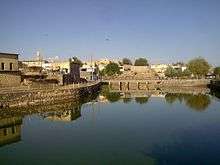Şırnak Province
| Şırnak Province Şırnak ili | |
|---|---|
| Province of Turkey | |
|
Damlabaşı, Şırnak Province | |
 Location of Şırnak Province in Turkey | |
| Country | Turkey |
| Region | Southeast Anatolia |
| Subregion | Mardin |
| Government | |
| • Electoral district | Şırnak |
| Area | |
| • Total | 7,172 km2 (2,769 sq mi) |
| Population (2010)[1] | |
| • Total | 483,788 |
| • Density | 67/km2 (170/sq mi) |
| Area code(s) | 0486[2] |
| Vehicle registration | 73 |
The Şırnak Province (Turkish: Şırnak ili, Kurdish: Parêzgeha Şirnex) is a Turkish province in Southeastern Anatolia Region. Şırnak borders Iraq and Syria. Şırnak was legally separated from Siirt province on May 16, 1990. This law also attached several districts from neighboring provinces of Siirt and Mardin, making them part of Şırnak, including Cizre and Silopi.
As of 2013, the province had an estimated population of 475,255 people.[3] The majority of the province's population is Kurdish.[4]
The 2015–16 Şırnak clashes are ongoing in Şırnak City, and its districts Cizre, Idil and Silopi.
Geography

The province borders Siirt Province to the north, Van Province to the northeast, Mardin Province to the west, Batman Province to the northwest, Syria to the southwest, and Iraq to the southeast.[5] Şırnak Province has some mountainous regions in the west and the south, but the majority of the province consists of plateaus, resulting from the many rivers that cross it. These include the Tigris, and its tributaries Hezil and Kızılsu, and also Çağlayan. The most important mountains are the Cudi (2089 m),[6] the Gabar, the Namaz and the Altın. Şırnak is the poorest province of Turkey with an average of 508 TL per capita.
Districts
Şırnak province is divided into 7 districts (capital district in bold):[3]
Background
Şırnak has been a focal point in Turkey's struggle against Kurdish separatist organization PKK.
Turkey's anti-terror operations against PKK began in 1984.[7] In 2013, PKK leader Abdullah Ocalan announced a ceasefire from the Turkish prison of Imrali,[8] where he has been serving a life sentence since 1999.[9]
The peace process collapsed in 2015.[10] Turkey's President Recep Tayyip Erdoğan said,
"It is not possible for us to continue the peace process with those who threaten our national unity and brotherhood."— Recep Tayyip Erdoğan[11]
Turkish Forces' operation, 1992
On 18 August 1992, Turkish forces, attacked the city, killing 54 people, mostly children and women. For three days, homes were burned, livestock were killed, people were brutally killed. 20,000 out of 25,000 residents fled the city, Amnesty International reported.[12][13]
During the operation, a curfew was imposed in the town and when it finally ended, the whole city was in ruins.
While the town was under bombardment, there was no way to get an account of what was happening in the region as journalists were prevented from entering the city centre which was completely burned down by the security forces. Şırnak was under fire for three days and tanks and cannons were used to hit buildings occupied by civilians.[14]
On 26 August 1992, Amnesty International sent requests to then Prime Minister, Süleyman Demirel, Interior Minister Ismet Sezgin, Emergency Legislation Governor Ünal Erkan and Şırnak province governor Mustafa Mala, to immediately initiate an independent and impartial inquiry into the events, to ensure no-one was mistreated in police custody and to make their findings public.
2016 Clashes
On March 14, 2016 a curfew was declared in Şırnak province. This marked the start of an 80 day long operation against Kurdish militant separatists in the province. The curfew remained in place for 9 months.[15] 2,044 buildings were destroyed during the military operation.[16]
References
| Wikimedia Commons has media related to Şırnak Province. |
- ↑ Turkish Statistical Institute, MS Excel document – Population of province/district centers and towns/villages and population growth rate by provinces
- ↑ Area codes page of Turkish Telecom website (in Turkish)
- 1 2 "Şırnak". Citypopulation.de. Retrieved 20 September 2014.
- ↑ Watts, Nicole F. (2010). Activists in Office: Kurdish Politics and Protest in Turkey (Studies in Modernity and National Identity). Seattle: University of Washington Press. p. 167. ISBN 978-0-295-99050-7.
- ↑ Google (20 September 2014). "Şırnak Province" (Map). Google Maps. Google. Retrieved 20 September 2014.
- ↑ Siirt 1973 (in Turkish). Ajans-Türk Matbaacilak Sanayii. 1973. p. 102.
- ↑ "Turkey's Southeast Beginning to Resemble Syria". al-monitor. June 13, 2016. Retrieved December 31, 2016.
- ↑ "Kurdish Leader Abdullah Ocalan Declares Ceasefire With Turkey". The Guardian. March 21, 2013. Retrieved December 31, 2016.
- ↑ "U.S. Helped Turkey Find and Capture Kurd Rebel". The New York Times. February 20, 1999. Retrieved December 31, 2016.
- ↑ "Turkey's Peace Process Floundered By Violence". Al Jazeera. August 1. 2015. Retrieved December 31, 2016. Check date values in:
|date=(help) - ↑ "Erdogan Says Kurdish Peace Talks Impossible To Continue". Al Jazeera. Retrieved December 31, 2016.
- ↑ amnesty.org
- ↑ 18 AUGUST 1992: WHEN ŞIRNAK WAS TURNED INTO A DEAD CITY
- ↑ nytimes
- ↑ "Turkey's Şırnak Now Nothing But Rubble". Al-Monitor. December 2, 2016. Retrieved December 31, 2016.
- ↑ "Şırnak'ta hasar tespiti yappıldı!..2 bin 44 ev yıkıldı". dogan haber ajansi (in Turkish). November 16, 2016. Retrieved December 31, 2016.
Coordinates: 37°26′58″N 42°34′28″E / 37.44944°N 42.57444°E
